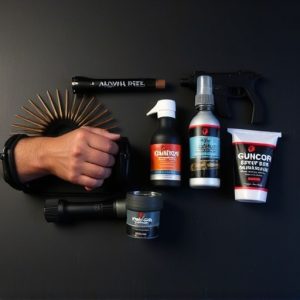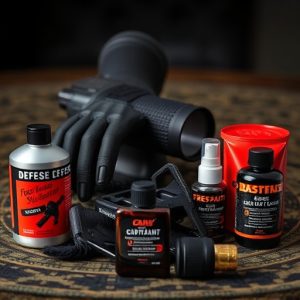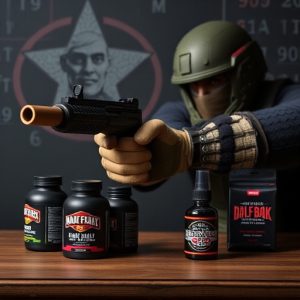Exploring Effective Personal Defense Products: A Look at Pepper Spray, ECDs, and Stun Guns
Personal defense products like pepper sprays and stun guns (including Tasers) offer safe, legal alte…….
Personal defense products like pepper sprays and stun guns (including Tasers) offer safe, legal alternatives for self-defense, designed to incapacitate attackers without causing serious harm. Pepper spray uses oleoresin capsaicin from chili peppers to create intense irritation upon contact with eyes or mucous membranes, deterring attackers and allowing for escape. Stun guns and ECDs deliver controlled electrical shocks that temporarily disable muscle function, providing a non-lethal way to neutralize threats. These devices are user-friendly, often requiring no special training and being legal in many jurisdictions. They serve as effective deterrents and offer a humane means of self-defense for those not wishing to use lethal force. It's essential to be well-informed about local laws regarding these products and to understand their proper use to ensure safety and legality. By incorporating such personal defense tools into one's safety plan, individuals can significantly enhance their ability to protect themselves in threatening situations. These products are endorsed by law enforcement for their effectiveness and contribute to a heightened sense of security and well-being.
When it comes to safeguarding one’s well-being, non-lethal defense options serve as a critical component of personal safety strategies. This article delves into the array of personal defense products available, focusing on their efficacy and appropriate use. From the potency of pepper spray to the role of Electronic Control Devices (ECDs) as a firearm alternative, we explore how these tools can be effectively utilized in self-defense scenarios. Understanding the legal, practical, and ethical considerations of stun guns and Tasers within non-lethal defense is essential for those seeking to protect themselves without resorting to deadly force.
Understanding Non-Lethal Defense Options for Personal Safety
When considering personal safety, non-lethal defense options serve as a prudent alternative to traditional weaponry. These personal defense products are designed to incapacitate an attacker temporarily without causing permanent harm or fatalities. Pepper sprays, for instance, deliver a powerful burst of oleoresin capsicoid, which irritates the eyes, skin, and respiratory system, effectively deterring aggressors. Stun guns, also known as Tasers, employ electric shock delivery systems to subdue assailants by disrupting their muscle control, rendering them temporarily immobile. Both of these options are widely recognized for their effectiveness in self-defense situations and are legal in many jurisdictions, making them accessible tools for personal protection.
In addition to sprays and stun devices, there are a variety of other personal defense products available on the market, including personal alarms that emit a loud sound to attract attention and deter would-be attackers, and defensive keychains with built-in sharp spikes for self-defense. Self-defense apps can also be a valuable resource, offering features like location sharing, real-time alarm activation, and emergency contacts notification directly from a smartphone. It’s important to familiarize oneself with local laws regarding the use of these personal defense products to ensure compliance and legal protection in case of an incident. Understanding and utilizing non-lethal defense options can significantly enhance one’s ability to respond to threatening situations, providing peace of mind and an additional layer of security for personal safety.
The Efficacy of Pepper Spray and Its Role in Self-Defense
When considering non-lethal defense options, pepper spray stands out as a highly efficacious personal defense product. Its active ingredient, oleoresin capsaicin, is a naturally occurring compound derived from chili peppers, which induces an intense irritation upon contact with mucous membranes and eyes. This reaction temporarily impairs the attacker’s vision, respiratory function, and ability to inflict harm, thereby providing the user with a critical window of escape or neutralization of the threat. The effectiveness of pepper spray is underscored by its widespread use among law enforcement and individual civilians alike. Its role in self-defense is particularly significant due to its accessibility, ease of operation, and legal status across various jurisdictions. Unlike firearms or traditional martial arts, pepper spray requires no specialized training or physical prowess to deploy effectively, making it a versatile component of personal defense products for those seeking a reliable method to protect themselves against potential assailants. Its non-lethal nature also aligns with the ethical considerations of self-defense, ensuring that the user’s response is proportionate to the threat faced.
Electronic Control Devices (ECDs) as a Safe Alternative to Firearms
When considering personal defense products, Electronic Control Devices (ECDs) emerge as a safe and effective alternative to firearms for deterring potential threats. These devices are specifically designed to incapacitate an attacker temporarily by delivering an electrical shock that overrides the body’s voluntary muscle control. ECDs are engineered with various safety features, such as multiple levels of intensity and an automatic shut-off after a certain period of use, ensuring they can be used without causing permanent harm. Unlike firearms, which require a clear line of sight and may result in fatal outcomes, ECDs allow for a more controlled and precise application of force. They are compact, easy to operate, and provide users with a non-lethal means to protect themselves during an encounter. ECDs are among the personal defense products that have been rigorously tested and approved by law enforcement agencies worldwide, making them a reliable choice for individuals seeking to safeguard their well-being in potentially dangerous situations without resorting to deadly force.
Strategic Use of Stun Guns and Tasers in Non-Lethal Defense Scenarios
Non-lethal defense tools like stun guns and Tasers have become increasingly prevalent in personal defense products arsenals, offering a significant alternative to traditional firearms. These devices are designed to incapacitate an attacker by delivering a high-voltage electric shock, which can temporarily disrupt the body’s muscular control and overpower an assailant without causing permanent harm. The strategic use of stun guns and Tasers is a critical component in non-lethal defense scenarios, as they can serve as a deterrent or a means to subdue a threat when other options are not viable or would be unsafe.
When integrating stun guns and Tasers into personal defense strategies, it’s crucial to understand their capabilities and limitations. These devices should be used in situations where an individual’s life or safety is at immediate risk and lethal force would be disproportionate. They are particularly effective when the attacker is larger or more physically capable than the defender, as the shock can neutralize the attacker quickly and effectively. It’s also important to note that proper training is essential for the safe and legal use of these devices. Users must be familiar with their operation, the potential effects on different individuals, and the circumstances under which they should be deployed. This knowledge ensures that these personal defense products are used responsibly and as intended, contributing to the safety and well-being of users and those around them in critical defensive situations.


